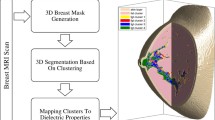Abstract
Anatomically realistic numerical breast models are essential tools for microwave breast imaging, supporting feasibility analysis, performance verification, and design improvements. Patient-specific models also assist in interpreting the results of the patient studies conducted on microwave imaging prototype systems. The proposed method employs automated and robust 3D processing techniques to construct flexible and reconfigurable breast models. These techniques include noise and artifact suppression with a principal component analysis (PCA) approach, and oversampling of the magnetic resonance imaging (MRI) data to enhance the intensity continuity. The k-means clustering segmentation identifies fatty and fibroglandular tissues and further segments these regions into a selected number of tissues, providing reconfigurable models. A peak Gaussian fitting technique maps the model clusters to the dielectric properties. The robustness of the proposed method is verified by applying it to both 1.5- and 3-T MRI scans as well as to scans of varying breast densities.
















Similar content being viewed by others
References
Fear EC, Sill J, Stuchly MA (2003) Experimental feasibility study of confocal microwave imaging for breast tumor detection. IEEE Trans Microw Theory Tech 51:887–892. https://doi.org/10.1109/TMTT.2003.808630
Li X, Davis SK, Hagness SC, VanderWeide DW, VanVeen BD (2004) Microwave imaging via space–time beamforming: experimental investigation of tumor detection in multilayer breast phantoms. IEEE Trans Microw Theory Tech 52:1856–1865. https://doi.org/10.1109/TMTT.2004.832686
Davis SK, Tandradinata H, Hagness SC, Van Veen BD (2005) Ultrawideband microwave breast cancer detection: a detection-theoretic approach using the generalized likelihood ratio test. IEEE Trans Biomed Eng 52:1237–1250. https://doi.org/10.1109/TBME.2005.847528
Sill JM, Fear EC (2005) Tissue sensing adaptive radar for breast cancer detection—experimental investigation of simple tumor models. IEEE Trans Microw Theory Tech 53:3312–3319. https://doi.org/10.1109/TMTT.2005.857330
Fear EC, Okoniewski M (2002) Confocal microwave imaging for breast tumor detection: application to a hemispherical breast model. In: 2002 I.E. MTT-S Int Microw Symp Dig (Cat No02CH37278) IEEE, pp 1759–1762
Hagness SC (2001) A confocal microwave imaging algorithm for breast cancer detection. IEEE Microw Wirel Components Lett 11:130–132. https://doi.org/10.1109/7260.915627
Zastrow E, Davis SK, Lazebnik M, Kelcz F, Van Veen BD, Hagness SC (2008) Development of anatomically realistic numerical breast phantoms with accurate dielectric properties for modeling microwave interactions with the human breast. IEEE Trans Biomed Eng 55:2792–2800. https://doi.org/10.1109/TBME.2008.2002130
Wang Z, Xiao X, Song H, Wang L, Li Q (2014) Development of anatomically realistic numerical breast phantoms based on T1- and T2-weighted MRIs for microwave breast cancer detection. IEEE Antennas Wirel Propag Lett 13:1757–1760. https://doi.org/10.1109/LAWP.2014.2353852
Tunçay AH, Akduman I (2015) Realistic microwave breast models through T1-weighted 3-D MRI data. IEEE Trans Biomed Eng 62:688–698. https://doi.org/10.1109/TBME.2014.2364015
Moftah HM, Azar AT, Al-Shammari ET, Ghali NI, Hassanien AE, Shoman M (2013) Adaptive k-means clustering algorithm for MR breast image segmentation. Neural Comput Appl 24:1917–1928. https://doi.org/10.1007/s00521-013-1437-4
Omer M, Kurrant D, Fear E (2016) Evaluating the impact of breast model complexity on microwave imaging signals. In: 2016 10th Eur. Conf. Antennas Propag. IEEE, pp 1–3
Fear EC, Bourqui J, Curtis C, Mew D, Docktor B, Romano C (2013) Microwave breast imaging with a monostatic radar-based system: a study of application to patients. IEEE Trans Microw Theory Tech 61:2119–2128. https://doi.org/10.1109/TMTT.2013.2255884
Bourqui J, Fear EC (2016) Average breast permittivity measurements: preliminary results from current patient study. In: 2016 10th Eur Conf Antennas Propag IEEE, pp 1–4
Dixon WT (1984) Simple proton spectroscopic imaging. Radiology 153:189–194. https://doi.org/10.1148/radiology.153.1.6089263
Szumowski J, Coshow WR, Li F, Quinn SF (1994) Phase unwrapping in the three-point Dixon method for fat suppression MR imaging. Radiology 192:555–561. https://doi.org/10.1148/radiology.192.2.8029431
Barret HH (2004) Foundations of image science, 3rd edn. John Wiley & Sons, Inc., New Jersey
Gonzalez RC, Woods RE (2002) Digital image processing, 2nd edn. Prentice Hall, Upper Saddle River
Interpolation for 3-D gridded data in meshgrid format. http://www.mathworks.com/help/matlab/ref/interp3.html
Lehmann TM, Gonner C, Spitzer K (1999) Survey: interpolation methods in medical image processing. IEEE Trans Med Imaging 18:1049–1075. https://doi.org/10.1109/42.816070
Ball GH, Hall DJ (1965) ISODATA, A novel method of data analysis and pattern classification. Stanford research institute Menlo Park, Stanford. http://www.dtic.mil/docs/citations/AD0699616
Lazebnik M, Popovic D, McCartney L, Watkins CB, Lindstrom MJ, Harter J, Sewall S, Ogilvie T, Magliocco A, Breslin TM, Temple W, Mew D, Booske JH, Okoniewski M, Hagness SC (2007) A large-scale study of the ultrawideband microwave dielectric properties of normal, benign and malignant breast tissues obtained from cancer surgeries. Phys Med Biol 52:6093–6115. https://doi.org/10.1088/0031-9155/52/20/002
O’Haver T (2016) A pragmatic introduction to signal processing with applications in scientific measurement. University of Maryland at College. https://terpconnect.umd.edu/~toh/spectrum/IntroToSignalProcessing.pdf. Accessed 30 Aug 2017
Kuhlmann M, Fear EC, Ramirez-Serrano A, Federico S (2013) Mechanical model of the breast for the prediction of deformation during imaging. Med Eng Phys 35:470–478. https://doi.org/10.1016/j.medengphy.2012.06.012
Bourqui J, Sill JM, Fear EC (2012) A prototype system for measuring microwave frequency reflections from the breast. Int J Biomed Imaging 2012:1–12. https://doi.org/10.1155/2012/851234
Acknowledgements
We would like to acknowledge our funding sources, including the Alberta Innovates Technology Futures (AITF) Strategic Chair, Alberta Innovates Health Solutions (AIHS), Vanier Canada Graduate Scholarship (CGS) and Izaak Walton Killam Memorial Scholarship. We are also grateful to Dr. Richard Frayne and Seaman Family MR Research Centre for acquisition of 3-T MRI scans, and radiologist Dr. Clare Romano.
Author information
Authors and Affiliations
Corresponding author
Rights and permissions
About this article
Cite this article
Omer, M., Fear, E.C. Automated 3D method for the construction of flexible and reconfigurable numerical breast models from MRI scans. Med Biol Eng Comput 56, 1027–1040 (2018). https://doi.org/10.1007/s11517-017-1740-9
Received:
Accepted:
Published:
Issue Date:
DOI: https://doi.org/10.1007/s11517-017-1740-9




